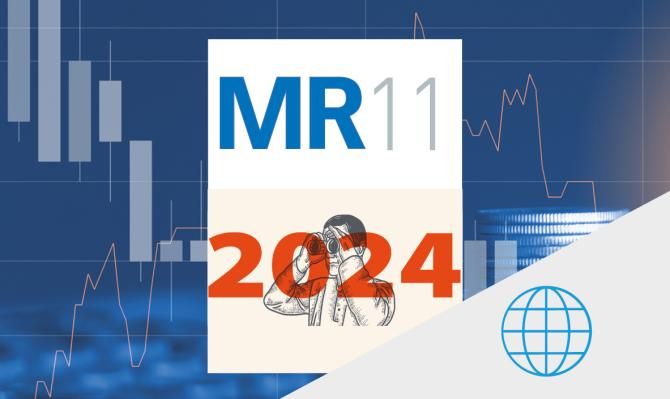Economic activity continues to digest the inflation rally which irrupted almost two years ago amid mismatches between supply and demand (derived from the pandemic) and the increase in energy and food prices (with the war in Ukraine). At first, the world economy showed greater resilience than expected. However, in recent quarters tight financial conditions have started to bite, driven by the central banks’ pursue of a restrictive policy, which is weighing particularly heavily on real estate markets, investment and economic activity. However, the cooling is more pronounced in advanced economies than in emerging economies, and within both groups there are notable exceptions, such as the resistance of the US in the former group and the difficulties which China is experiencing in the latter.

US GDP grew by an impressive 1.2% quarter-on-quarter in Q3 2023, more than double the average for the first half of the year (+0.5%) and with a solid composition (private consumption grew by 1.0%, public consumption by 1.1% and residential investment increased by 1.0% after nine consecutive quarters of setbacks). This resistance shown by economic activity has not stopped the reduction in inflation, which continues to converge towards the Fed’s 2% target. However, in September the CPI offered mixed signals. Specifically, headline inflation remained unchanged at 3.7% year-on-year, mainly due to the rise in energy prices. Core inflation, on the other hand, fell 0.2 percentage points to 4.1%. However, its month-on-month dynamics were less encouraging than in previous months, with a stable rate of 0.3%, while the breakdown by component showed an acceleration in the inflation of shelter (0.6% vs. 0.3% in August), which accounts for over 40% of the core index.

In the euro area, GDP fell by 0.1% in Q3 after growing by 0.2% in Q2 (revised upwards by 0.1 pp). In part, this figure reflects the volatility of GDP in Ireland (–1.8% quarter-on-quarter vs. +0.5% in Q2), although excluding the Irish data the euro area would have virtually stagnated in Q3. This slowdown in economic activity occurred across almost all the major economies, with a 0.1% quarter-on-quarter decline recorded in Germany (following stagnation in the first half of the year), moderate growth of 0.1% in France (not so modest if we consider that the 0.6% growth rate in Q2 was heavily supported by temporary effects, after which a reversal could have been expected) and stagnation in Italy (0.0% in Q3 vs. –0.4% in Q2), while Spain showed greater buoyancy (0.3%).

The positive side of the cooling of euro area activity can be found in inflation, with the latest data reinforcing the prospect of it being bent to 3% in the coming months. In particular, headline inflation in the euro area fell sharply in October to 2.9% year-on-year (–1.4 pps), while core inflation fell to 4.2% (–0.3 pps). The region as a whole had not seen such low levels since the summer of 2021 (headline inflation) and the summer of 2022 (in the case of core inflation). The fall in October reflected a strong base effect in energy prices (which registered a year-on-year contraction of 11.1%, undoing the stress in the energy component experienced in the autumn of 2022). Nevertheless, and significantly, a sustained slowdown was also observed in all other components, most notably in the case of industrial goods (–0.6 pps) and services (–0.1 pps). In addition, according to the seasonally adjusted estimates of the HICP published by the ECB, annualised month-on-month inflation stood at –0.1% (headline) and 1.2% (core) in October, while inflation momentum stood at 4.5% (headline) and 3.2% (core).

In the euro area, the first indicators available for Q4 indicate a continuity of the recent sluggish economic activity: in October, the PMI remained in contractionary territory, both in industry (43.1 points) and in services (47.8, the lowest level since early 2021). Moreover, this weakness was widespread across the bloc (the composite PMI remained in contractionary territory in Germany, France and Italy). In the US, in contrast, the composite PMI for October remained in slightly expansive territory (50.7) and improved moderately in both manufacturing (50.0 vs. 49.8 in September) and services (50.6 vs. 50.1). Also, in October the US labour market created 150,000 jobs, a positive figure but below the pre-pandemic average rate, while the unemployment rate rose slightly to 3.9%.

Although China’s economic activity continues to be hampered by an ongoing crisis in the real estate sector, GDP grew by a significant 1.3% quarter-on-quarter in Q3 2023, following 0.5% growth recorded in Q2 (revised 0.3 pps downwards). In year-on-year terms, growth slowed to 4.9% (vs. 6.3% in Q2), reflecting the fading of the base effects which were present in the previous quarter as a result of the lockdowns in force in Q2 2022. On the positive side, the economic activity indicators showed an improvement during the course of the quarter, with retail sales (5.5% year-on-year in September vs. 4.6% in August) pointing to a recovery in private consumption. In contrast, the slowdown in investment intensified (+3.1% year-on-year vs. 3.8% up to Q2), affected by the persistent weakness of the real estate sector. As for the initial data available for Q4, the Caixin PMIs continue to paint a picture of an economy that is struggling to sustain its post-pandemic recovery, with a composite index lying at the stagnation threshold in October (50 points), a slight decline in manufacturing (49.5) and a slight improvement in services (50.4).

